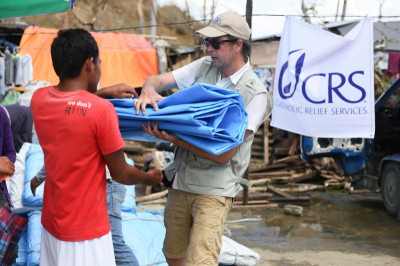
Catholic Relief Services: Faith. Action. Results.
Editor's Note: This article is a contribution to a week-long blog carnival on USAID's John Ogonowski and Doug Bereuter Farmer-to-Farmer (F2F) Program. From July 14-18, F2F program partners and American volunteers are sharing their knowledge and experience of providing technical assistance to farmers, farm groups, agribusinesses, service providers, and other agriculture sector institutions in developing and transitional countries. This blog carnival aims to capture and share this program experience. You can find all contributions on Agrilinks.

At a glance:

Where did CRS come from?
CRS was originally founded by the Catholic Bishops of the United States to serve World War II survivors in Europe. Today, CRS has expanded to reach almost 100 million people in 93 countries on five continents. As part of the Universal Church, CRS works with local Catholic institutions around the world, but also participates in development and humanitarian initiatives undertaken by a wide range of groups, including governments, other faith communities, and secular institutions.
Also from This Series
|
What are CRS' goals?
CRS works in the spirit of Catholic Social Teaching to assist impoverished and disadvantaged people overseas. CRS promotes sustainable economic growth, food security, and agricultural development worldwide with programs focusing on:
- Promoting prosperous and resilient agricultural livelihoods,
- Strengthening competitiveness in existing commercial value chains for specific commodities,
- Promoting the participation of women and supporting the equitable livelihoods of female farmers, and
- Cultivating strong relationships across civil society and public and private sectors.
How does CRS do it?
CRS helps rural families improve food security and economic engagement by guiding them through three stages of development:
- Recovery—encouraging gender-equitability, aiding in emergency response, reducing disaster risk, facilitating better national resource management and nutrition-sensitive programming;
- Building—helping farmers engage better with markets through a “5 skills set” approach;
- Growing—using finance, regional commodity and trade programs, policy and advocacy to broker the inclusion of organized smallholder farmers in the formal agriculture sector.
What are some of CRS' successes?
- In Zimbabwe, the Masakhane savings and lending group provides families with alternative incomes—especially for women. Together, the women of Masakhane the saved the equivalent of $7,000 in less than a year—enough for the members to start poultry businesses, buy livestock, and open market stalls.
- The village of Worla in Liberia now has two separate microfinance saving clubs called Remember and Love. The members of Remember just elected a woman as the leader of the club, an indicator of her hard work and the respect she holds in her community.
- The Support Our Youth project in Ecuador has improved the quality of education and transformed educational centers into places of learning instead of working. SOY helps with school improvement planning as well as providing scholarships for uniforms and school supplies.
As aligned with Feed the Future, the U.S. Government's global hunger and food security initiative, F2F works to support inclusive agriculture sector growth, facilitate private sector engagement in the agriculture sector, enhance development of local capacity and promote climate-smart development. Volunteer assignments address host-led priorities to expand economic growth that increases incomes and improves access to nutritious food. Read more articles on this topic on Agrilinks. Also, make sure to subscribe to receive a daily digest in your inbox, for one week only!

